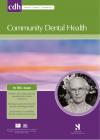Community Dental Health

- Cover Date:
- December 2011
- Print ISSN:
- 0265 539X
- Vol:
- 28
- Issue:
- 4
Prevalence of periodontopathogens in a black Brazilian secluded community matched with a black urban population
Objective: To evaluate the prevalence of periodontopathogens according to periodontal profile in a black Brazilian secluded community matched with an urban black population. Participants: A total of 84 subjects were selected, 42 (mean age 25.7 sd 18.0 years) from a secluded community called Santo Antonio do Guapore (SAG) and 42 (mean age 25.4 sd 18.1 years) from an urban area of Sao Paulo State (SPT). Methods: Participants received clinical examinations as follows: periodontal pocket depth; clinical attachment loss; plaque and gingival indexes. After examination, the secluded population was classified as periodontal health (13), gingivitis (15) or periodontitis (14). Then, 182 urban volunteers were screened and 42 subjects were selected matched for the variables: periodontal diagnosis, age (±2 years) and gender. Samples were taken for microbial analysis. Genomic DNA for Aggregatibacter actinomycetemcomitans, Porphyromonas gingivalis, Campylobacter rectus, Tannerella forsythia and Prevotella intermedia was provided by polymerase chain reaction. Results: Except for C. rectus, all pathogens were present in both groups with no statistically significant difference. In particular, C. rectus was more prevalent only in gingivitis subjects from the SPT group (p<0.05). A high frequency of periodontopathogens was related to the severity of periodontal disease. Conclusion: In general, the prevalence of the examined periodontopathogens in this study did not differ between a secluded black Brazilian population and an urban black population.
Key Words: periodontitis, ethnic groups, polymerase chain reaction, bacteria.
- Article Price
- £15.00
- Institution Article Price
- £
- Page Start
- 301
- Page End
- 304
- Authors
- J.D. Bonifácio, D.R. Aquino, G.C.N. Franco, S.C. Cortelli, K. Cogo, J. Guimarães dos Santos, F.O. Costa, J.R.Cortelli
Articles from this issue
- Title
- Pg. Start
- Pg. End
- Why has oral health promotion and prevention failed children requiring general anaesthesia for dental extractions?
- 255
- 258
- Predictors of utilisation of dental care services in a nationally representative sample of adults
- 269
- 273
- Applicability of both dentist and patient perceptions of dentists’ explanations to the evaluation of dentist–patient communication
- 274
- 279
- Evaluation of a preventive program based on caries risk among mentally challenged children using the Cariogram model
- 286
- 291
- The effect of a modified fluoride toothpaste technique on buccal enamel caries in adults with high caries prevalence: a 2-year clinical trial
- 292
- 296
- Association of clinical oral health status with self-rated oral health and GOHAI in Japanese adults
- 297
- 300
- Prevalence of periodontopathogens in a black Brazilian secluded community matched with a black urban population
- 301
- 304
- Incisor trauma in a Turkish preschool population: Prevalence and socio-economic risk factors
- 308
- 312
- Malocclusion and orthodontic treatment need measured by the Dental Aesthetic Index and its association with dental caries in Indian schoolchildren
- 313
- 316
